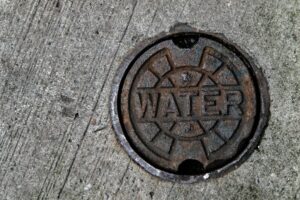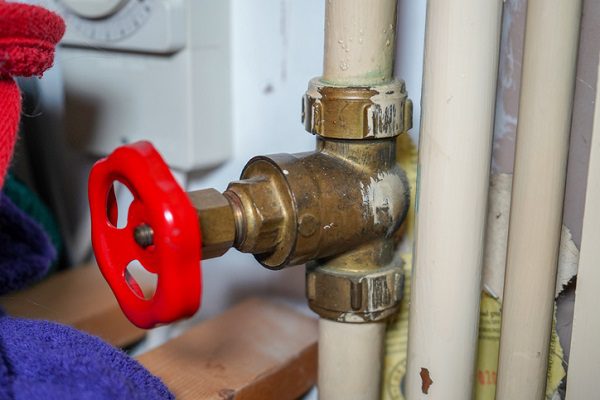Weather is becoming more extreme every year. That means higher risks of flash floods and storm surges, even in places normally not used to it. Today, we’ll give you some guidance on how to find your home’s water main (shutoff valve). Knowing where your water shutoff valve is can prevent catastrophic flood damage, longer-term plumbing damage, and help you stop plumbing leaks. It’s also something that’s just good to know.
Where Is Your Home Water Main (Shutoff Valve)?
There’s no standard location for a water shutoff valve. Generally, there are four different places where your water shutoff valve is likely to be.
- Inside your house, likely on a wall on the street side of your house
- In warmer climates, outside your home near an outside faucet
- Outside your house, near your curb, under a plastic or metal lid likely marked water
- Outside your house, near your private well pump and/or near your pressure tank
The first three options apply if you use municipal water (i.e., city water). The fourth option applies if you use well water. So, the first step in finding your main water shutoff valve is figuring out whether your water supply is municipal or well. In general (but not always), if you pay a water bill, chances are you use municipal water.
Now, let’s look at some specific tips for finding each kind of water shutoff valve. The best time to do this is before you need to. So, take a few minutes on a nice day to look for your shutoff valve, instead of waiting until you need to know where it is.
Where to Look INSIDE Your House for the Shutoff Valve
First, start by going outside to the front of your house. Look for a faucet that comes out from the wall on the outside. This will help you narrow down where your indoor water shutoff valve might be.
Next, go back inside and to the lowest part of your house (basement or first floor). Recall where the outdoor faucet was. Walk to the location on your inside wall, about where the outside faucet appears on the outside. If you see either a lever or a wheel valve connected to metal pipes, you’ve likely found your water shutoff valve. (If not, go to the next section.)
Then, turn the valve clockwise (to the right) until it stops. If it’s a lever-style valve (i.e., ball valve), you’ll turn it a quarter turn so that the valve is perpendicular (i.e., like a cross) to the pipe it’s connected to. If it’s a wheel-style valve (i.e., gate valve), turn the wheel clockwise until it stops.
IMPORTANT: When you want to turn your water back on, GO SLOW. If you go too fast, you can damage your plumbing or even cause pipes to burst. So, slowly turn the valve counterclockwise to turn it back on.
Where to Look OUTSIDE Your House for the Shutoff Valve
There are three places outside your house where your shutoff valve may be.
1. Near an outside faucet
If you live in a warmer climate, check the faucets connected to your house. You’ll likely see that one of your faucets has either a lever or wheel valve right next to it. That’s your shutoff valve.
Turn the valve clockwise (to the right) until it stops. It it’s a lever-style valve (i.e., ball valve), you’ll turn it a quarter turn so that the valve is perpendicular (i.e., like a cross) to the pipe it’s connected to. If it’s a wheel-style valve (i.e., gate valve), turn the wheel clockwise until it stops.
REMEMBER: When turning the water back on, GO SLOW. If you go too fast, you can damage your plumbing or even cause pipes to burst. So, slowly turn the valve counterclockwise.

2. In the ground near your curb
If you didn’t find your main water supply inside or connected to your house, check your street-side curb. Your shutoff valve may be housed in a cement box with a plastic or metal lid that says water. You’ll need a water meter key, which you can buy at a hardware store, or sturdy pliers for this.
First, you’ll first want to remove the lid. If the lid is locked, you’ll need to call your municipal water service for instructions on how to open it.
If there’s dirt or sand inside, remove it and put it to the side. You’ll need to put it back when you’re through, as the dirt or sand prevents freezing.
Next, you’ll likely see two valves. Only use the valve that is closest to your house. The other valve is the city valve, which you don’t want to fiddle with. (You likely won’t be able to, since it requires special tools, but just steer clear of it entirely.)
Using the water meter key or your pliers, turn the valve clockwise to close it. Reverse the process to turn it back on. But remember: When turning the water back on, GO SLOW with your counterclockwise turn.
3. Near your private well’s pump and pressure tank
If you have a private well, you may have two valves to turn off.
Check near your well’s pump and then near the pressure tank. Turn both (or just the one if there’s only one) clockwise to turn the water off. And remember: When turning the water back on, GO SLOW with your counterclockwise turn.

For Outstanding Protection, Consider 2-10
Knowing how to turn off your home water main can save your budget, your house, and your life. Use these tips to find your main and turn it off when necessary.
Another way to protect your budget is with a Home Warranty Service Plan from 2-10 Home Buyers Warranty. A 2-10 Home Warranty can cover systems like your plumbing when they break down from routine use. We also offer coverage for well pumps as an additional option.
While a 2-10 Home Warranty Service Plan won’t cover flood damage, it can still provide coverage for major items you use every day, like your plumbing, water heater, and refrigerator.









